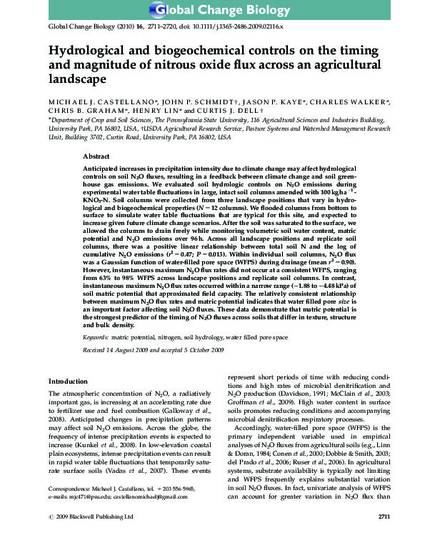
Article
Hydrological and biogeochemical controls on the timing and magnitude of nitrous oxide flux across an agricultural landscape
Global Change Biology
(2010)
Abstract
Anticipated increases in precipitation intensity due to climate change may affect hydrological
controls on soil N2O fluxes, resulting in a feedback between climate change and soil greenhouse
gas emissions. We evaluated soil hydrologic controls on N2O emissions during
experimental water table fluctuations in large, intact soil columns amended with 100 kg ha1 -
KNO3-N. Soil columns were collected from three landscape positions that vary in hydrological
and biogeochemical properties (N512 columns). We flooded columns from bottom to
surface to simulate water table fluctuations that are typical for this site, and expected to
increase given future climate change scenarios. After the soil was saturated to the surface, we
allowed the columns to drain freely while monitoring volumetric soil water content, matric
potential and N2O emissions over 96 h. Across all landscape positions and replicate soil
columns, there was a positive linear relationship between total soil N and the log of
cumulative N2O emissions (r250.47; P50.013). Within individual soil columns, N2O flux
was a Gaussian function of water-filled pore space (WFPS) during drainage (mean r250.90).
However, instantaneous maximum N2O flux rates did not occur at a consistent WFPS, ranging
from 63% to 98% WFPS across landscape positions and replicate soil columns. In contrast,
instantaneous maximum N2O flux rates occurred within a narrow range (1.88 to 4.48 kPa) of
soil matric potential that approximated field capacity. The relatively consistent relationship
between maximum N2O flux rates and matric potential indicates that water filled pore size is
an important factor affecting soil N2O fluxes. These data demonstrate that matric potential is
the strongest predictor of the timing of N2O fluxes across soils that differ in texture, structure
and bulk density.
Keywords
- matric potential,
- nitrogen,
- soil hydrology,
- water filled pore space
Disciplines
Publication Date
August 19, 2010
DOI
10.1111/j.1365-2486.2009.02116.x
Publisher Statement
Works produced by employees of the U.S. Government as part of their official duties are not copyrighted within the U.S. The content of this document is not copyrighted.
Citation Information
Michael J. Castellano, John P. Schmidt, Jason P. Kaye, Charles Walker, et al.. "Hydrological and biogeochemical controls on the timing and magnitude of nitrous oxide flux across an agricultural landscape" Global Change Biology Vol. 16 Iss. 10 (2010) p. 2711 - 2720 Available at: http://works.bepress.com/castellano-michael/23/
